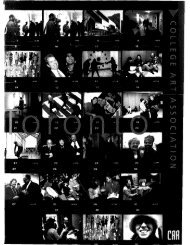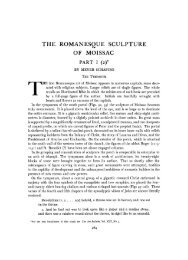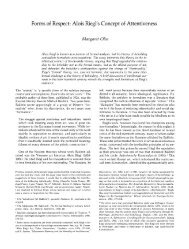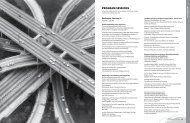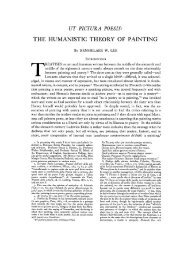Tragic Pompeii - College Art Association
Tragic Pompeii - College Art Association
Tragic Pompeii - College Art Association
Create successful ePaper yourself
Turn your PDF publications into a flip-book with our unique Google optimized e-Paper software.
228 THE ART BULLETIN JUNE 1994 VOLUME LXXVI NUMBER 2<br />
Al I<br />
..........<br />
.......<br />
..............MI,<br />
4 Frontispiece from F. Niccolini, Le case ed i monumenti di Pom-<br />
pei disegnati e descritti, I, Naples, 1854-96<br />
First, the urge to document and record the remains as they<br />
were found informs the volumes of H. Roux Ain6 and J.<br />
Barre (1839-40), W. Zahn (1829, 1859), and F. Niccolini<br />
(1854-96), as well as numerous loose engravings, watercol-<br />
ors, and temperas. The most thorough treatment to date is<br />
still that by the Frenchman, D. Raoul-Rochette, whose text of<br />
1828 with its watercolors and drawings, now itself frag-<br />
mented and divided between Rome and Paris, offers invalu-<br />
able evidence of the house before its disassembly, weather-<br />
ing, and final rebuilding.12<br />
The other desire was a creative, or rather re-creative, urge<br />
to make the fragment whole, seen in the engraving by Sir<br />
William Gell, whose Pompeiana of 1832 became a best-selling<br />
handbook for English tourists (Fig. 5). Using a pane of glass,<br />
Gell traced an original drawing of the house, outfitted the<br />
12 H. Roux Aine and M. L. Barre, Herculaneum et Pompe'i. Recueil gendral<br />
des peintures, bronzes, mosaiques, etc., Paris, I, 1840, 94-103; 11, 1839,<br />
216-225; III, 1840, 3-5, 30-31, 56-57, 90-91; W. Zahn, Die schdnsten<br />
Ornamente und merkwiirdigsten Gemalde aus Pompei, Herculaneum und<br />
Stabiae, I, Berlin, 1829, pls. 20, 23, 33, 43; II, 1859, pls. 10, 17, 42, 59; F.<br />
Niccolini, Le case e i monumenti di Pompei disegnati e descritti, Naples,<br />
1854-96, I, 1-16, pls. 1-6; D. Raoul-Rochette, Choix des monuments<br />
inidits. I. Maison du Poete Tragique a Pompei, Paris, 1828.<br />
interior in period style, and inserted the ancient Pompeians<br />
themselves. This reanimation of the house inspired the<br />
dwelling of Edward Bulwer-Lytton's protagonist Glaucus in<br />
The Last Days of <strong>Pompeii</strong> (1832), which was dedicated to Gell.<br />
Carefully described in all its parts, parts given Latin names,<br />
Bulwer-Lytton's verbal reconstruction would spawn numer-<br />
ous additional examples in prints, paintings, and films for<br />
the next century.'3<br />
In France too, archaeology and fiction combined to repro-<br />
duce the house. A photograph by Alfred-Nicolas Normand,<br />
architect of Prince Jerome Napoleon, is today an important<br />
document of surviving details in 1851; yet his aim was not to<br />
record the house but to use it as a model in designing the<br />
prince's Pompeian Palace on the rue Montaigne in Paris.<br />
There Jerome Napoleon and his friends emulated what they<br />
imagined had been a Pompeian life of elegant leisure by<br />
dressing in togas and enjoying ancient skits. Gustave Bou-<br />
langer captured just such a scene in his Rehearsal of "The Flute<br />
Player" in the Atrium of the House ofH.I.H. The Prince Napoleon,<br />
1861 (Fig. 6). The composition is freely based upon the<br />
mosaic emblema from the tablinum floor of the House of the<br />
<strong>Tragic</strong> Poet (Fig. 7), and was rendered in an academic,<br />
illusionistic style that captured the palace's amalgam of past<br />
and present just as the ancient Roman house had appropri-<br />
ated the forms of the more ancient Greek culture.14<br />
Indeed, it was the very illusionism of the decor in the<br />
House of the <strong>Tragic</strong> Poet that stirred the nineteenth-century<br />
memory of another literary source, Petronius's Satyricon,<br />
written about the time the interior was decorated.'5 The<br />
13 W. Gell, Pompeiana: The Topography, Edifices and Ornaments of <strong>Pompeii</strong>,<br />
the Result of the Excavations since 1819, I, London, 1835, 142-178; II,<br />
95-122; the reconstruction of the atrium: pl. xxxvii, 96-99; E. Bulwer-<br />
Lytton, The Last Days of <strong>Pompeii</strong>, London, 1832, chap. 3. To this list must<br />
be added at least four built models of the house, including one made for<br />
Mussolini's Mostra Augustea of 1938, now in the Museo della Civilta<br />
Romana; see Bragantini, 164, and B. Andreae, "Modelle pompejanischer<br />
Bauten," Pompeji: Leben und Kunst in den Vesuvstddten, exh. cat.,<br />
Villa Hugel, Essen, 1975, 215, 250. On the European reception of<br />
<strong>Pompeii</strong>, see W. Leppmann, <strong>Pompeii</strong> in Fact and Fiction, London, 1968;<br />
E. C. Corti, The Destruction and Resurrection of <strong>Pompeii</strong> and Herculaneum,<br />
London, 1951; R. Trevelyan, The Shadow of Vesuvius: <strong>Pompeii</strong> AD 79,<br />
London, 1976; R. Brilliant, <strong>Pompeii</strong> A.D. 79: The Treasure of Rediscovery,<br />
New York, 1979, and on this house: 107-108, 141-173; Pompe'i<br />
1748-1980, 11-56; Pompei. Travaux et envois des architectes frangais au<br />
XIX siecle, exh. cat., Ecole Nationale Superieure des Beaux-<strong>Art</strong>s, Paris,<br />
1981; Pompei e gli architettifrancesi dell '800, Naples, 1981.<br />
4 Alfred-Nicolas Normand: Architecte, photographies de 1851/52, exh. cat.,<br />
Archives Photographiques de la Direction de l'Architecture, Paris, 1978,<br />
19, no. 54; Prince Napoleon's Palace: T. Gautier, Le Palais pomplien:<br />
Etudes sur la maison greco-romaine, Paris, 1861; M.C. Dejean de la Batie,<br />
"La Maison pompeienne du Prince Napoleon Avenue Montaigne,"<br />
Gazette des beaux-arts, LXXXVII, 1976, 127-34; The Second Empire 1852-<br />
1870: <strong>Art</strong> in France under Napoleon III, exh. cat., Philadelphia Museum of<br />
<strong>Art</strong>, 1978, 63-64; on Boulanger: 59-60.<br />
'15 The paintings of the House of the <strong>Tragic</strong> Poet have been dated, by<br />
style, both to the Neronian and the Vespasianic periods. I follow the<br />
Neronian dating based on the close similarity between features of the<br />
surrounding decoration, in particular the black frieze of the atrium, and<br />
that of the Temple of Isis in <strong>Pompeii</strong>, whose restoration is securely dated<br />
by an inscription to A.D. 62. An execution after A.D. 68 would not<br />
substantially alter my interpretation. On the problematic dating of the<br />
Fourth Style: V. M. Strocka, "Die r6mische Wandmalerei von Tiberius<br />
bis Nero," Pictores per provincias (Aventicum v), 1987, 29-44; R. Thomas,<br />
"Zur Chronologie des dritten und vierten Stils," KdlnerJahrbuch fiir Vorund<br />
Friihgeschichte, xxiv, 1991, 153-158; R. Ling, "German Approaches<br />
to <strong>Pompeii</strong>,"Journal of Roman Archaeology, vi, 1993, 331-340.



